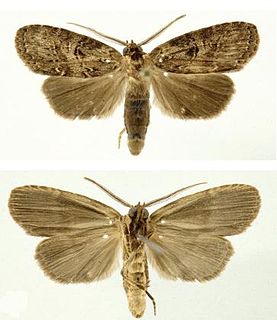Erbessa albilinea is a moth of the family Notodontidae first described by James S. Miller in 2008. It is found in Costa Rica.
Erbessa tegyroides is a moth of the family Notodontidae first described by James S. Miller in 2008. It is found in south-eastern Peru.
Phanoptis donahuei is a moth of the family Notodontidae. It is found in southern Mexico.
Argentala brehmi is a moth of the family Notodontidae first described by James S. Miller in 2008. It is endemic to the eastern slope of the Andes.
Polypoetes copiosa is a moth of the family Notodontidae. It has a restricted distribution along the foothills of the Andes in western Ecuador.
Polypoetes corneola is a moth of the family Notodontidae. It is found in south-eastern Peru.
Polypoetes forficata is a moth of the family Notodontidae. It is found in eastern Ecuador.
Polypoetes leuschneri is a moth of the family Notodontidae first described by Miller in 2008. It is endemic to the Pacific slope of the Ecuadorian Andes.
Polypoetes tinalandia is a moth of the family Notodontidae. It is found along the Pacific slope of the Ecuadorian Andes.
Brachyglene albicephala is a moth of the family Notodontidae first described by James S. Miller in 2008. It is endemic to the northern half of Costa Rica.
Chrysoglossa norburyi is a moth of the family Notodontidae first described by James S. Miller in 2008. It is found in Costa Rica.
Nebulosa yanayacu is a moth of the family Notodontidae first described by James S. Miller in 2008. It is found along the eastern slope of the Ecuadorian Andes.
Tithraustes lambertae is a moth of the family Notodontidae. It occurs in wet forests on the Caribbean slope in Costa Rica.
Tithraustes snyderi is a moth of the family Notodontidae. It is found in cloud-forest habitats within La Amistad, an international park extending from south-central Costa Rica into the Chiriqui Province of Panama.

Dunama jessiebarronae is a moth in the family Notodontidae. It is found in Costa Rica, where it is only known from the eastern slopes of the Cordillera Volcanica de Guanacaste, Cordillera Volcanica Central, Cordillera de Talamanca, llanuras de Sarapiqui, and the lowlands of the Caribbean, at elevations ranging from 50 to 1,115 meters.

Dunama janewaldronae is a moth in the family Notodontidae. It is found in Costa Rica, where it is known from the eastern side of the Cordillera Volcanica de Guanacaste at elevations ranging from 400 to 680 meters.

Dunama jessiebancroftae is a moth in the family Notodontidae. It is found in Costa Rica, where it is known from the Peninsula de Nicoya, and the lowland of central Pacific Costa Rica, at elevations ranging from 50 to 1,286 metres.

Dunama janecoxae is a moth in the family Notodontidae. It is found in Costa Rica, where it is known from the Cordillera Volcanica de Guanacaste and the eastern slope of the Cordillera de Tilaran and Talamanca, occurring at elevations ranging from 1,090 to 1,185 meters.

Dunama indereci is a moth in the family Notodontidae. It is found in Costa Rica, where it is known from the Villa Blanca, in San Ramon, Alajuela province, at an elevation of 1,115 meters in a montane pass between Costa Rica’s Cordillera de Tilaran and the Volcanica Central.
Dunama mattonii is a moth in the family Notodontidae. It is found in Ecuador.




